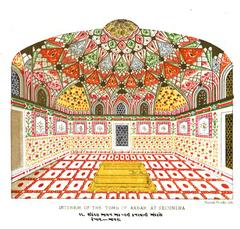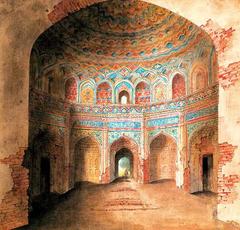Diwan-I-Am Agra: Visiting Hours, Tickets, and Complete Tourist Guide
Date: 04/07/2025
Introduction: The Majesty and Significance of Diwan-I-Am
The Diwan-I-Am, or Hall of Public Audience, stands as a magnificent testament to Mughal heritage within the UNESCO-listed Agra Fort in Agra, India. Commissioned by Emperor Shah Jahan in the 17th century, it was here that the emperor engaged with his subjects, dispensed justice, and showcased imperial authority. The Diwan-I-Am is a masterwork of Mughal architecture, blending Persian, Timurid, and Indian styles, and continues to fascinate millions of visitors each year with its historical resonance and stunning artistry (indiano.travel; culturalindia.net).
This guide provides a comprehensive overview of Diwan-I-Am’s origins, architecture, visitor information—including hours, tickets, and accessibility—plus tips for a memorable visit, photographic highlights, and related attractions around Agra Fort (agratourism.co.in; Trawell.in; audiala.com; traveltriangle.com).
Table of Contents
- Introduction
- Historical Origins and Construction
- Architectural Features and Mughal Aesthetics
- Function and Cultural Significance
- Historical Context and Patronage
- Later History and Preservation
- Visitor Experience: Highlights and Photo Spots
- Practical Visitor Information: Hours, Tickets, Accessibility
- Travel Tips and Etiquette
- Special Events and Guided Tours
- FAQs
- Conclusion & Visitor Recommendations
- Sources
Historical Origins and Construction
The Diwan-I-Am forms a central part of the Agra Fort complex. Built between 1628 and 1635 CE under Shah Jahan, it epitomizes Mughal architectural advancement and imperial power (indiano.travel). Agra Fort, originally constructed by Akbar in 1573, was later expanded by his successors, with Shah Jahan adding several ornate halls and palaces to reflect evolving governance and aesthetics (culturalindia.net).
Designed for public audiences, the hall facilitated direct communication between the emperor and his subjects, reinforcing the Mughal ideal of accessible and just rule (agratourism.co.in).
Architectural Features and Mughal Aesthetics
The Diwan-I-Am is a large rectangular pavilion, originally built in red sandstone and later finished with white shell plaster to mimic marble (culturalindia.net). Measuring about 201 feet by 67 feet, the hall features 40 intricately carved pillars with floral and lotus motifs and a series of multi-cusped arches. The open arcaded design and high ceilings allowed for large gatherings and symbolized imperial transparency (indiano.travel).
A raised marble throne platform (jharokha) at one end, lavishly decorated with inlay work and precious stones, was used by the emperor during courtly proceedings (trip101.com). The blending of Persian, Central Asian, and indigenous Indian design elements is characteristic of Shah Jahan’s era, echoed in other masterpieces like the Taj Mahal (culturalindia.net).
Function and Cultural Significance
The Diwan-I-Am was the heart of public life in the Mughal court. Here, Shah Jahan and his successors heard grievances, resolved disputes, and received dignitaries, projecting an image of fairness and accessibility (indiano.travel). Ceremonial events, such as the famed “Jharokha Darshan,” further elevated the emperor’s authority and spectacle.
A notable feature outside the hall was “Jahangir’s Chain of Justice,” a golden chain that allowed subjects to demand direct redress, underscoring the Mughal commitment to justice (trip101.com).
Historical Context and Patronage
The construction of the Diwan-I-Am was made possible by the Mughal Empire’s wealth and centralized governance under Shah Jahan (culturalindia.net). Built by thousands of artisans over eight years, Agra Fort’s imposing walls and halls—spanning over 2.5 kilometers—served both as a stronghold and a symbol of imperial grandeur.
The Diwan-I-Am at Agra Fort predates and differs in style from its counterpart at the Delhi Red Fort, illustrating the evolution of audience halls in the Mughal tradition (culturalindia.net).
Later History and Preservation
With the Mughal capital’s shift to Delhi in 1638, the Diwan-I-Am’s administrative use declined. The British later repurposed portions of Agra Fort for military and administrative functions, but the hall’s architectural integrity and historical associations were preserved (culturalindia.net). As part of the UNESCO World Heritage Site, the Diwan-I-Am remains carefully maintained and open to visitors worldwide (agratourism.co.in).
Visitor Experience: Highlights and Photographic Spots
- Marble Throne Platform (Jharokha): Central to Mughal rituals and perfect for close-up photos (indiano.travel).
- Pillared Hall: Rows of carved pillars create impressive perspective shots.
- Floral and Lotus Motifs: Capture the detailed Indo-Persian artistry on pillars and arches (culturalindia.net).
- Open Arcades: Wide-angle photography highlights the hall’s scale and elegance.
Practical Visitor Information
Location & Access
- Address: Inside Agra Fort, Rakabganj, Agra, Uttar Pradesh (indiano.travel).
- Nearby: About 2.5 km from the Taj Mahal; easily reached by taxi, auto-rickshaw, or local transport. The nearest railway stations are Agra Fort and Agra Cantonment (India OnGo; India Easy Trip).
Visiting Hours
- Open daily: 6:00 AM to 6:00 PM (sunrise to sunset) (audiala.com; TravelTriangle; India OnGo).
Tickets (2025 rates)
- Indian citizens: ₹35–50
- Foreign nationals: ₹550–650
- Children under 15: Free
- SAARC/BIMSTEC: ₹60
- ADA Toll Tax: ₹10 (Indians), ₹50 (foreigners)
- Purchase: At the fort entrance or online; bring valid ID (Travel with CG).
Facilities & Amenities
- Restrooms & Water: Available near entrances.
- Accessibility: Paved pathways, wheelchair rentals (advance notice recommended). Some uneven terrain.
- Security: Security checks at entry; large bags, food, and some electronics restricted.
- Photography: Allowed in most areas; drones and tripods require special permission.
Travel Tips and Etiquette
- Best times to visit: Early morning (6:00–8:00 AM) or late afternoon (after 4:00 PM) for fewer crowds and optimal lighting.
- Guided tours: Highly recommended—available in multiple languages for deeper insight (audiala.com).
- Dress & Comfort: Modest, comfortable clothing; sturdy shoes. Carry water, especially in summer.
- Cultural etiquette: Maintain decorum, avoid loud conversations, and do not touch or climb on monuments.
- Avoid Fridays: Taj Mahal closure means larger crowds at Agra Fort.
Special Events and Guided Tours
- Guided tours with licensed guides or audio devices are available at the ticket counter.
- Occasional cultural performances and heritage walks are held within the fort; check with Uttar Pradesh Tourism for schedules.
Frequently Asked Questions (FAQ)
Q1: What are the Diwan-I-Am visiting hours?
A: Open daily from 6:00 AM to 6:00 PM, sunrise to sunset.
Q2: How can I buy tickets?
A: At the Agra Fort entrance or online through official tourism websites.
Q3: Is Diwan-I-Am wheelchair accessible?
A: Main pathways are paved; wheelchairs can be rented with advance notice.
Q4: Is photography allowed?
A: Yes, but avoid using flash near delicate artwork; drones/tripods need special permission.
Q5: Are guided tours available?
A: Yes, private and group guides can be arranged on-site or in advance.
Nearby Attractions
- Within Agra Fort: Jahangiri Mahal, Khas Mahal, Sheesh Mahal, Musamman Burj, Moti Masjid.
- Nearby: Taj Mahal (2.5 km), Mehtab Bagh, local bazaars (Kinari, Sadar).
- Fatehpur Sikri: Another Mughal UNESCO site 40 km away (India Easy Trip).
Light and Sound Show
An evening light and sound show narrates Agra Fort’s history, including Diwan-I-Am’s role. Tickets are sold separately; check showtimes and details via the Uttar Pradesh Tourism website (India OnGo).
Conclusion & Visitor Recommendations
The Diwan-I-Am at Agra Fort is a living testament to the grandeur of Mughal architecture and the ideals of just, accessible governance. Its intricate design and rich history make it a must-visit for anyone exploring Agra’s heritage. For the best experience, plan your visit for early morning or late afternoon, secure tickets in advance, and consider a guided tour to appreciate the site’s full significance.
Before you go, download the Audiala app for up-to-date hours, ticket bookings, and in-depth guides. Follow official sources and trusted travel blogs for real-time updates and tips.
Sources and Further Reading
- indiano.travel
- culturalindia.net
- agratourism.co.in
- traveltriangle.com
- Trawell.in
- India OnGo
- audiala.com
- India Easy Trip
- Travel with CG







